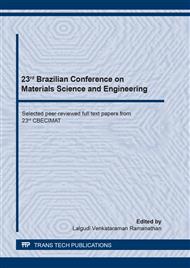p.100
p.109
p.114
p.119
p.125
p.131
p.136
p.141
p.147
The Effect of Vacuum Annealing and HDDR Processing on the Electrochemical Characteristics of Activated Carbon and Graphene Oxide for the Production of Supercapacitors Electrodes
Abstract:
Electric double-layer capacitors prepared using activated carbons have been subjected to vacuum heat treatments at low and high temperatures (200, 400, 600, 800 and 1000°C). The electrodes have been tested at a potential of 1.1 V employing a KOH electrolyte (1.0and 6.0 mol.L-1). The effect of or HDDR upon the electrical properties has been investigated by cyclic voltammetry. It has been shown that the specific capacitance at 5 msV-1 increases from 50 Fg-1 to 130 Fg-1 after a heat treatment at 400°C for 1 hour under back pump vacuum. At 400°C the diminution in the specific capacitance with higher scanning rate (10 msV-1) was much less pronounced (from 130 Fg-1 to 100 Fg-1). Equivalent series resistance (ESR) and equivalent parallel resistance of supercapacitors electrodes have also been investigated. Internal resistances of the supercapacitors were calculated using the galvanostatic curves at current densities (100 mAg-1).A compositional and morphological evaluation of these electrodes showed no significant change on the activated carbon structure.
Info:
Periodical:
Pages:
125-130
Citation:
Online since:
October 2020
Authors:
Price:
Сopyright:
© 2020 Trans Tech Publications Ltd. All Rights Reserved
Share:
Citation:


